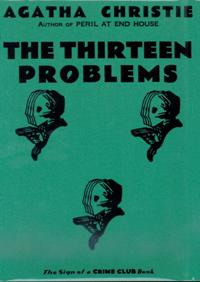
The Thirteen Problems: “Unsolved mysteries.”
Detective: Miss Marple
Published: June 1932
Compilation: Short Stories
Length: 256 pages
Setting: St. Mary Mead, Downshire (fictional)
During two different dinner parties in St. Mary Mead, Miss Marple is host and guest. There is a suggestion of the sharing of puzzling mysteries, where one person in the group tells a story and the others surmise its outcome or solution. Surprisingly, the small town spinster, Miss Marple, demonstrates her superior brain power and deductive skills. As each dinner guest shares a puzzling mystery and the others surmise the solution, Miss Marple is able to navigate all the clues, both obvious and unexpected, to solve each mystery in her quiet yet practical manner.
The Thirteen Problems or thirteen stories, each with a puzzling conundrum. They are as follows:
The Tuesday Night Club: A gathering at Miss Marple’s house includes her nephew, Raymond West; a former head of Scotland Yard, Sir Henry Clithering; an artist, Joyce Lemprière; a clergyman, Dr. Pender; and a solicitor, Mr. Petherick. Sir Henry tells the story: Mr. and Mrs. Jones and Miss Clark sit down to dinner; all are poisoned but Mrs. Jones dies. It is found that she is the victim of arsenic poisoning and her husband was known to rely on her wealth. Each person at the party offers his or her solution to the mystery of who killed Mrs. Jones but Miss Marple ends up providing the answer.
The Idol House of Asarte: Dr. Pender is next to relate a tale of a house party in Dartmoor where there was a grove, like the grove of Asarte. Diana, a guest with a wild imagination, assumes a priestess-like costume and the host, Sir Richard, falls dead as he approaches her, stabbed through the heart although no one approached him and no weapon is found. Later his cousin is stabbed in the same manner. After the other guests take a stab at the answer (ha, ha!), again, Miss Marple supplies the explanation for the crime.
Ingots of Gold: Raymond West, Miss Marple’s nephew, begins his story with a tale of visiting a friend of his in Cornwall, John Newman, who goes missing and is later found bound and gagged in a ditch. Close by, there is a tale of a Spanish Armada shipwreck, as well as a recent one, both rumoured to contain gold. Newman said he was set up and tossed into a lorry when he saw a boat bringing something to the beach on Smuggler’s Cove and then hiding the cargo in a cave. Inspector Badgworth found evidence of use of the cave and the lorry tires matched the suspiciously acting pub owner, Kelvin. But a neighbour’s nurse testifies that the lorry never left the house that evening so Kelvin evades arrest. What happened? Only Miss Marple can unravel the mystery.
The Blood-Stained Pavement: Joyce Lemprière says when she was in Rathole, Cornwall, two cars pulled up, and the man, Denis, from the couple in the first car, recognizes Carol, the woman in the second. They all agree to go bathing together but Carol plans to walk to meet them there. Joyce is surprised to see bloodstains on the pavement but hears that Carol did not return and no one knows where she is. Although Denis and his wife, Margery, drive off, it is reported two days later that Margery is found drowned after diving and hitting her head on a rock. Are two women dead? How could this be? However, Miss Marple can explain.
Motive v. Opportunity: Mr. Petherwick has a story. A client of his, Simon Clode, had nearly all his family die, including a beloved granddaughter, so he had the three children of his brother come to live with him. Clode came under the influence of a spiritualist, Mrs. Spragg, but eventually the husband of the eldest niece pronounces her a fraud, to the anger of Clode who changed his will, giving five thousand each to his brother’s children and the rest to the Spraggs, in spite of Petherwick’s protestations. But upon Clode’s death, the will was opened and found to be blank. Who could have exchanged the will? Mrs. Spragg had been alone with the will but why would she destroy something in her favour? It is all a puzzle until Miss Marple straightens it all out!
The Thumb Mark of St. Peter: The final story of the Tuesday Club is told by Miss Marple. Her niece, Mabel, married a man against sound advice, as he had a violent temper and insanity in his family. When he died, Miss Marple’s offer to stay with Mabel was refused; then two months later she received a missive from Mabel begging her to come because rumours were circulating that she was responsible for her husband’s death. Upon arriving, Miss Marple is completely puzzled by what she learns but eventually a prayer and a haddock lead her to the devious killer.
A year has passed before Sir Henry Clithering is once more in St. Mary Mead as a guest of Colonel Arthur and Dolly Bantry who acquiesce to his suggestion of an invitation to Miss Marple to dinner, as her penchant for solving mysteries is unparalleled. Thus another mystery-solving dinner is assembled with these four persons, an actress named Jane Heller and Dr. Lloyd.
The Blue Geranium: Arthur Bantry has a friend, George Pritchard, whose wife is not only a hypochondriac but also has a penchant for fortune-tellers and her present one, Zelda, has told her that her house is evil and to avoid blue flowers. Eventually Mrs. Pritchard is found dead in bed with a geranium on the wallpaper turned blue. Zelda has disappeared without trace and no one can deduce what has happened. But Miss Marple can!
The Companion: Dr. Lloyd relates his story which occurred in Las Palmas, Gran Canaria. Two women tourists from England were staying at the hotel, Miss Mary Barton and Miss Amy Durant. Whilst swimming, Miss Durant, gets caught in a strong current and although Miss Barton rushes into the water to save her, the woman drowns. However one witness claims Miss Barton had held the other woman’s head under the water and Miss Barton, revealing that Miss Durant was her companion, begins to ask Dr. Lloyd strange legal questions such as taking the law into one’s hands. Later, Dr Lloyd reads in the papers that Miss Barton drowned in Cornwall, confessing to the first drowning. But a body was never found and it takes Miss Marple’s quick intelligence to unravel the clues and solve the mystery.
The Four Suspects: Sir Henry Clithering tells of a secret German society and of Dr. Rosen who managed to bring down the society, yet then he was a marked man. He lived in a secluded area of Somerset in a cottage with his niece, a servant, a gardener and a secretary, who in fact was one of Clithering’s men. Yet Dr. Rosen is killed in a fall down the stairs. The house was locked and each of the four persons were out at the time, yet none have an alibi. Miss Marple is able to determine not only the killer but how the killer received his/her instructions.
A Christmas Tragedy: Miss Marple relates a tale based on feelings and intuition of when she was visiting Keston Spa Hydro and knew without a doubt that a man, Jack Sanders, was going to murder his wife, Gladys, for her money. Mrs. Sanders is eventually found dead but her husband has an alibi. However, no one has accounted for Miss Marple’s superior intellect as she unravels a rather cunning murder to bring the killer to justice.
The Herb of Death: the Bantry’s were at a dinner at the house of Sir Ambrose Bercy where everyone at the meal was poisoned with digitalis and Sir Ambrose’s ward, Sylvia, dies from it. It is suspected foxglove, growing among the sage, was picked with it and added to the dinner. Yet it was Sylvia who picked the herbs herself. Did she mean to commit suicide? Or was it her fiancé, Jerry, who was seen kissing another of the guests and marries her after Sylvia’s death? Miss Marple is able to puzzle out the clues and comes to a shocking resolution.
The Affair at the Bungalow: Jane Heller relates this story of a man by the name of Leslie Faulkner who is arrested for burglary. He claimed he had sent a play to Jane who invited him to her bungalow to meet her, whereupon he’d been given a drink and remembered no more. However, the bungalow belonged to someone else who claims Faulkner attempted to gain admittance and is later seen trying to go through a window. The bungalow has been robbed and jewelry stolen. But when Jane is brought to the police station, Faulkner claims she is not the woman he spoke with. What is going on? Everyone is puzzled but Miss Marple whispers words in Jane’s ear and we discover this is a very different mystery than the usual.
Death by Drowning: time has passed since the dinner party but Sir Henry has returned to the Bantry’s as a guest when word comes that a local girl, Rose Emmott, has been found drowned in the river close to the mill. It is believed she was pregnant by a young man and killed herself so as not to have to tell her father. Miss Marple appears and claims the death is a murder. With absolutely no evidence, she hands a piece of paper with the name of the suspect on it to Sir Henry and pleads for him to investigate. Is the murderer Rose’s lover? Or is it her father? Or perhaps Joe Ellis, a rather dim young man who was enamoured of Rose? Eventually, with Miss Marple’s direction, the murderer is apprehended.
This was an especially fun compilation of short stories structured in quite a brilliant form. The dinner parties and the tales of mysteries lent another fun aspect to the reading adventure. And in spite of the other characters being subservient to Miss Marple’s deductive capabilities and, in fact, the stories themselves, Christie does an excellent job of presenting their different personalities.
Another stellar performance by the Queen of Mystery!










Pingback: Peril at End House by Agatha Christie - Classical CarouselClassical Carousel
Glad to hear this collection is good!
It is! She’d only written one Miss Marple novel before this. I wonder if she was developing the character to write more.
I remember the blue geranium story, but the rest are gone from my memory and now I need to read this collection again!
Absolutely! I try to forget all Agatha Christie mysteries after I read them so I can read them again. 😀
This is the only Agatha Christie I own (yet) but I remember it was a blast! I’ll have to reread it one of these days 😀
The ONLY Agatha Christie?!!! Shocking! 😉 And it’s quite an obscure one to have. I do hope you get to read it again!
I think this is the only Miss Marple I haven’t read. I need to find it!
Yes, do! Read it ….. it will be a fun experience!
This is one of my favourite Agatha Christie collection. All the stories are well written and craftily plotted. Absolutely brilliant
I agree! As usual when it comes to opinions, our generally coincide!
This sounds brilliant, thank you! I am a lifelong Christie fan, but I don’t think I have read those!
Oh my, you’re in for a treat! It’s not one of my favourite short story collections.
Pingback: Lord Edgware Dies by Agatha Christie - Classical CarouselClassical Carousel